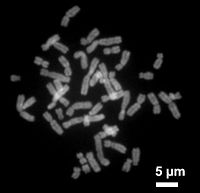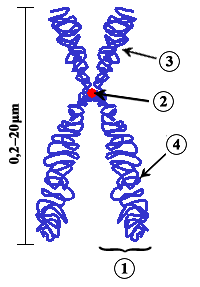Linkage map
A linkage map is a chromosome map of a species or experimental population that shows the position of its known genes and/or markers relative to each other in terms of recombination frequency, rather than as specific physical distance along each chromosome.
A genetic map is a map based on the frequencies of recombination between markers during crossover of homologous chromosomes. The greater the frequency of recombination (segregation) between two genetic markers, the farther apart they are assumed to be. Conversely, the higher the frequency of association between the markers, the smaller the physical distance between them. Historically, the markers originally used were detectable phenotypes (enzyme production, eye color) derived from coding DNA sequences; eventually, confirmed or assumed noncoding DNA sequences such as microsatellites or those generating restriction fragment length polymorphisms (RFLPs) have been used.
Genetic maps help researchers to locate other markers, such as other genes by testing for genetic linkage of the already known markers.
A genetic map is not a gene map.
LOD score method for estimating recombination frequency
The lod score (logarithm (base 10) of odds, also called logit by mathematicians) is a statistical test often used for linkage analysis in human populations, and also in animal and plant populations. The test was developed by Newton E. Morton. Computerized lod score analysis is a simple way to analyze complex family pedigrees in order to determine the linkage between mendelian traits (or between a trait and a marker, or two markers).
The method is described in greater detail by Strachan and Read [1]. Briefly, it works as follows:
- Establish a pedigree
- Make a number of estimates of recombination frequency
- Calculate a lod score for each estimate
- The estimate with the highest Lod score will be considered the best estimate
The Lod score is calculated as follows:

NR denotes the number of non-recombinant offspring, and R denotes the number of recombinant offspring. The reason 0.5 is used in the denominator is that any alleles that are completely unlinked (e.g. alleles on separate chromosomes) have a 50% chance of recombination, due to independent assortment.
In practice, lod scores are looked up in a table which lists lod scores for various standard pedigrees and various values of recombination frequency.
By convention, a lod score greater than 3.0 is considered evidence for linkage. (A score of 3.0 means the likelihood of observing the given pedigree if the two loci are not linked is less than 1 in 1000). On the other hand, a lod score less than -2.0 is considered evidence to exclude linkage. Although it is very unlikely that a LOD score of 3 would be obtained from a single pedigree, the mathematical properties of the test allow data from a number of pedigrees to be combined by summing the LOD scores.
Recombination frequency
Recombination frequency (θ) is when crossing-over will take place between two loci (or genes) during meiosis. Recombination frequency is a measure of genetic linkage and is used in the creation of a genetic linkage map. A centimorgan (cM) is a unit that describes a recombination frequency of 1%.
During meiosis, chromosomes assort randomly into gametes, such that the segregation of alleles of one gene is independent of alleles of another gene. This is stated in Mendel's Second Law and is known as the law of independent assortment. The law of independent assortment always holds true for genes that are located on different chromosomes, but for genes that are on the same chromosome, it does not always hold true.
As an example of independent assortment, consider the crossing of the pure-bred homozygote parental strain with genotype AABB with a different pure-bred strain with genotype aabb. A and a and B and b represent the alleles of genes A and B. Crossing these homozygous parental strains will result in F1 generation offspring with genotype AaBb. The F1 offspring AaBb produces gametes that are AB, Ab, aB, and ab with equal frequencies (25%) due to the law of independent assortment. Note that 2 of the 4 gametes (50 %)—Ab and aB—were not present in the parental generation. These gametes represent recombinant gametes. Recombinant gametes are those gametes that differ from both of the haploid gametes that made up the diploid cell. In this example, the recombination frequency is 50% since 2 of the 4 gametes were recombinant gametes.
The recombination frequency will be 50% when two genes are located on different chromosomes or when they are widely separated on the same chromosome. This is a consequence of independent assortment.
When two genes are close together on the same chromosome, they do not assort independently and are said to be linked. Whereas genes located on different chromosomes assort independently and have a recombination frequency of 50%, linked genes have a recombination frequency that is less than 50%.
As an example of linkage, consider the classic experiment by William Bateson and Reginald Punnett. They were interested in trait inheritance in the sweet pea and were studying two genes—the gene for flower color (P, purple, and p, red) and the gene affecting the shape of pollen grains (L, long, and l, round). They crossed the pure lines PPLL and ppll and then self-crossed the resulting PpLl lines. According to Mendelian genetics, the expected phenotypes would occur in a 9:3:3:1 ratio of PL:Pl:pL:pl. To their surprise, they observed an increased frequency of PL and pl and a decreased frequency of Pl and pL (see chart below).
Bateson and Punnett experiment | Phenotype and genotype | Observed | Expected from 9:3:3:1 ratio |
| Purple, long (P_L_) | 284 | 216 |
| Purple, round (P_ll) | 21 | 72 |
| Red, long (ppL_) | 21 | 72 |
| Red, round (ppll) | 55 | 24 |
Their experiment revealed linkage (or coupling) between the P and L alleles and the p and l alleles. The frequency of P occurring together with L and with p occurring together with l is greater than that of the recombinant Pl and pL. The recombinantion frequency cannot be computed directly from this experiment, but intuitively it is less than 50%.
The progeny in this case received two dominant alleles linked on one chromosome (referred to as coupling or cis arrangement). However, after crossover, some progeny could have received one parental chromosome with a dominant allele for one trait (eg Purple) linked to a recessive allele for a second trait (eg round) with the opposite being true for the other parental chromosome (eg red and Long). This is referred to as repulsion or a trans arrangement. The phenotype here would still be purple and long but a test cross of this individual with the recessive parent would produce progeny with much greater proportion of the two crossover phenotypes. While such a problem may not seem likely from this example, unfavorable repulsion linkages do appear when breeding for disease resistance in some crops.
When two genes are located on the same chromosome, the chance of a crossover producing recombination between the genes is directly related to the distance between the two genes. Thus, the use of recombinantion frequencies has been used to develop linkage maps or genetic maps.
http://en.wikipedia.org/wiki/Genetic_mapping




